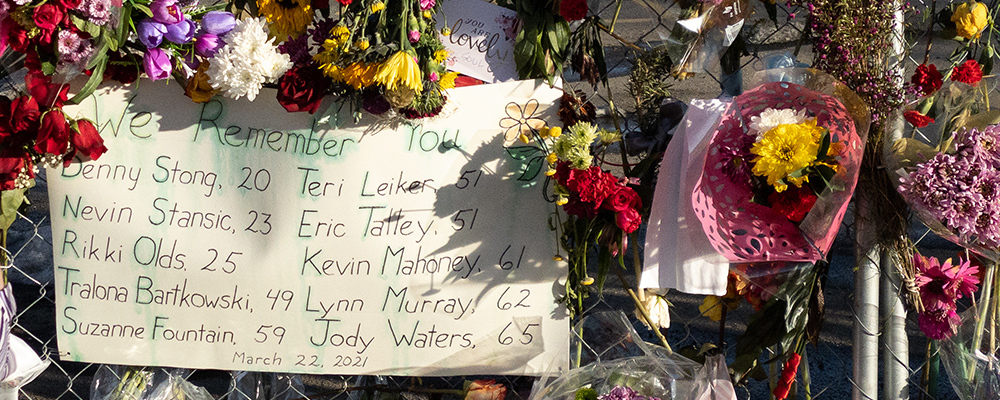 An impromptu memorial for the March 22 Boulder shooting victims stand near the scene of the violence. ©Uwe Lubjuhn, 2021.
An impromptu memorial for the March 22 Boulder shooting victims stand near the scene of the violence. ©Uwe Lubjuhn, 2021.
As many of you know, Boulder, Colorado—home to the Natural Hazards Center—was recently upended by a mass shooting that left 10 people dead.
Our hearts are shattered by this horrific act and the unimaginable sorrow it has wrought. But your care has reminded us of how we will begin to heal. Thank you to everyone who reached out with messages of support and solidarity, and for those who allowed us to grieve quietly. We know that many of you consider Boulder as home—a place where we have gathered every summer during the annual Natural Hazards Workshop for more than four decades now.
In this Director’s Corner post, I would like to offer some lessons that I’ve learned from young people that helped me to process this tragedy. I hope their wisdom will be of use to you as well.
On that Monday, March 22, 2021, I was in the middle of lecturing to my virtual 400-student Intro to Sociology class at the University of Colorado Boulder, when I noticed the Zoom chat box suddenly filling with comments. Thrilled that my students were engaging with the course content, I paused to read some of their messages. They weren’t about the class.
“Active shooter at King Soopers on Table Mesa, hope everyone’s safe.”
“Yeah, I’m following the news. I can hear the helicopters and sirens from my house.”
“There’s a livestream of it on YouTube.”
“Don’t watch the beginning of the livestream if you don’t want to see disturbing things! HUGE trigger warning.”
I’ve studied disasters for more than 20 years now—including acts of intentional violence—and I’m still unprepared for the immediate emotions these incidents spark. In the moment, and after decades of mass shootings in our society, I stumbled to say something comforting to the mostly 18- and 19-year-olds I teach. But words can’t soothe the fact that these young people have known so much adversity in their short lives.
Consider, for example, that March 2020 was the first March since 2002—the year that many of my current students were born—in which there hadn’t been a school shooting in this nation. Or that they now have the dubious recognition of being known as Gen C, or the COVID-19 Generation. Along with these distinctive burdens, they also regularly cope with climate disasters, teen suicide, the ongoing opioid crisis, and numerous other issues that contribute to cumulative trauma.
My class reconvened the following Wednesday, this time fully aware of the magnitude of the shootings that unfolded when we were last together. Having reflected on the lessons I’ve learned from other disaster-affected children and youth over the years, I was better prepared to support my students. I suggest the following:
Stop and acknowledge the trauma. There is so much pressure, especially in higher education, to forge ahead with the next assignment or lecture. But considering all that has happened with the pandemic, continued struggles for racial justice, the recent shootings in Atlanta and all of the other tragedies that have followed, my students expressed a desperate need to just take a moment and process their grief.
Keep a routine. While taking time is important, routine is also vital. I had considered cancelling class on Wednesday to give my students space. However, one of the key things that Alice Fothergill and I learned from studying children after Hurricane Katrina was that young people need routine to reestablish a sense of normalcy, as well as to reconnect with supportive adults and peers. Isolation can be detrimental during times of collective disruption, so it is useful to stick to a routine even when some aspects of it need to be altered.
Invite children and youth to share their feelings. Adults can sometimes underestimate young people’s trauma because they are known to actively hide their distress from their parents and teachers. Disaster-affected teens, in particular, have told me that they won’t express their emotions because they don’t want to further burden their overstressed caregivers. That is why it is crucial to actively encourage young people to share not just what they need, but also what they know. Rather than lecturing during the class period following the shooting, I asked the students if there was anything they wanted to share with their classmates. They offered support to one another and traded resources such as mindfulness tips, meditation apps, music play lists, funny videos, and other things that help them find joy.
Recognize differences. Although disasters disrupt entire communities, not everyone is affected equally. For instance, those children and youth with pre-existing mental health concerns may experience amplified distress after a disaster. Young people living in poverty and those with less social support often have a harder time coping with and recovering from disaster. Keep this variability in mind when addressing disaster-affected youth and ensure that resources are shared in ways that recognize and respect these differences.
Whether you’re an educator searching for the right thing to say after yet another tragedy or anyone else charged with the well-being of young people, these approaches can be helpful. But also remember that the words you say might have far less impact than the words you hear. Our students have become unwitting experts on disasters. Let’s learn from them and act in ways that honor the lessons they have to teach us.
Please take care of yourself and others.
Lori Peek, Director
Natural Hazards Center